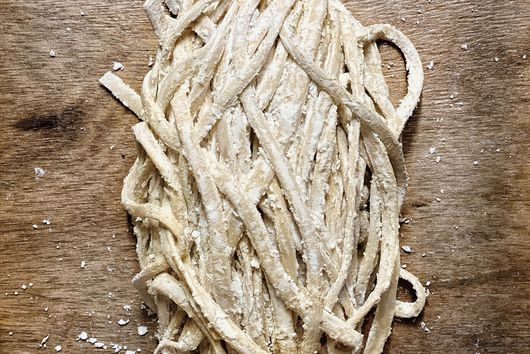Homemade Ramen Noodles
★★★★★
PREP TIME
1 hour 15 minutes
COOK TIME
2 minutes
MAKES
3 servings
Ingredients
1/2 cup
plus 2 tablespoons (150 grams) water
1 1/2 teaspoons
baked baking soda (at 250°F for 1 hour)
1 1/2 teaspoons
sea salt
1
large egg
2 1/3 cups
(295 grams) all-purpose flour
3/4 cup
(90 grams) tapioca starch
Instructions
- In a stand mixer bowl with dough hook, mix together water, sodium carbonate, sea salt, and egg until even. Add all-purpose flour and mix on low-speed until even, then increase to medium-high speed and knead for 10 minutes until a very wet and elastic dough forms. The dough should be super wet but not so much so that it immediately falls off the dough-hook when the tilt-head is lifted. If it does, adjust with a couple tablespoons more flour. Transfer the dough to a large bowl with the measured tapioca starch on the bottom. Cover and let rest for 30 minutes. If your kitchen is very warm, let rest in the fridge.
- I recommend using a pasta roller attachment with the stand mixer to roll out the dough, but a hand-cranked pasta roller can work, too. If you have neither, you can also roll the dough out with a rolling pin but obviously it would require more work. Dredge the rested dough inside the bowl with tapioca starch and place on a working surface. Use a rolling pin to roll it out into a longer sheet, then dust very generously with more tapioca starch. Only use the tapioca starch from the bowl so that you know the exact amount that you're using. Fold the sheet in half then roll it out again. Repeat this about three to four times until the very sticky dough is now not so sticky that it would get caught inside the pasta-roller. You would probably have incorporated about 1/3 of the tapioca into the dough at this point. If you don't have a pasta roller, continue the following step with the rolling pin.
- Set the pasta roller on its widest setting and set the speed at 2 instead of 1 (this passes the dough faster and lowers the chance of it being stuck). Generously dredge the dough with the remaining tapioca and roll it out into a long strip. Pass the dough through the roller, then fold in half, and pass it through again, each time adding and dredging it with tapioca as you work the tapioca into the dough. Once you've used up all the tapioca, pass the dough through the roller a couple more times until it becomes silky smooth and even to the touch, with a minimally damp feel to the surface but is completely non-sticky. DO NOT try to work more tapioca into the dough at this point because you will make the dough too dry and it will start to tear.
- The thickness at the widest setting of the pasta roller makes for a noodle that is perfect as thick-cut ramen (often used for tsukemen, my favorite). If you want a thinner noodle, you can go down to the second widest setting, or cut with a spaghetti pasta cutter, but I would not go any thinner. To cut the noodles, dust the dough with more tapioca (which prevents sticking better than wheat flour because it doesn't absorb water and becomes sticky), then fold the dough to the length of your knife and cut noodles that are as wide as the thickness. Dredge the cut noodles with more tapioca then wrap each individual portion with plastic wrap. You can keep them in the fridge for up to 24 hours or in the freezer for up to four month.
- To cook, bring a very large pot of water to a raging boil. Dust the excess starch off the noodle and add to the pot, then gently stir with chopstick to make sure each strands are separated and not clumped up. Once the water comes back to a boil, cook for about 2 minutes for thick-cut noodles and 1 minute for thin-cut for hot broth ramen, until there is only a small white dot in the middle of the noodle when bitten through. For tsukemen, cook 1 minute more until the noodles are cooked through, then immediately chill the noodle in iced water.





